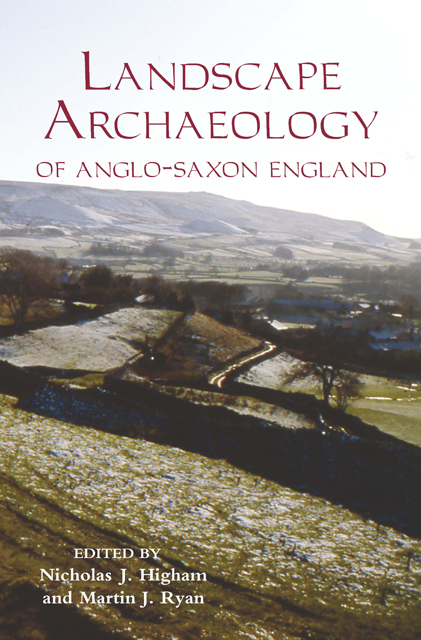Book contents
- Frontmatter
- Contents
- List of Illustrations
- Contributors
- Acknowledgements
- Abbreviations
- 1 The Landscape Archaeology of Anglo-Saxon England: An Introduction
- 2 Barriers to Knowledge: Coppicing and Landscape Usage in the Anglo-Saxon Economy
- 3 Landscape Change during the ‘Long Eighth Century’ in Southern England
- 4 Population Ecology and Multiple Estate Formation: The Evidence from Eastern Kent
- 5 Exploring Black Holes: Recent Investigations in Currently Occupied Rural Settlements in Eastern England
- 6 Medieval Field Systems and Settlement Nucleation: Common or Separate Origins?
- 7 The Environmental Contexts of Anglo-Saxon Settlement
- 8 Calendar Illustration in Anglo-Saxon England: Realities and Fictions of the Anglo-Saxon Landscape
- 9 The Anglo-Saxon Plough: A Detail of the Wheels
- 10 ‘In the Sweat of thy Brow Shalt thou eat Bread’: Cereals and Cereal Production in the Anglo-Saxon Landscape
- 11 The Early Christian Landscape of East Anglia
- 12 The Landscape and Economy of the Anglo-Saxon Coast: New Archaeological Evidence
- Index
8 - Calendar Illustration in Anglo-Saxon England: Realities and Fictions of the Anglo-Saxon Landscape
Published online by Cambridge University Press: 16 February 2023
- Frontmatter
- Contents
- List of Illustrations
- Contributors
- Acknowledgements
- Abbreviations
- 1 The Landscape Archaeology of Anglo-Saxon England: An Introduction
- 2 Barriers to Knowledge: Coppicing and Landscape Usage in the Anglo-Saxon Economy
- 3 Landscape Change during the ‘Long Eighth Century’ in Southern England
- 4 Population Ecology and Multiple Estate Formation: The Evidence from Eastern Kent
- 5 Exploring Black Holes: Recent Investigations in Currently Occupied Rural Settlements in Eastern England
- 6 Medieval Field Systems and Settlement Nucleation: Common or Separate Origins?
- 7 The Environmental Contexts of Anglo-Saxon Settlement
- 8 Calendar Illustration in Anglo-Saxon England: Realities and Fictions of the Anglo-Saxon Landscape
- 9 The Anglo-Saxon Plough: A Detail of the Wheels
- 10 ‘In the Sweat of thy Brow Shalt thou eat Bread’: Cereals and Cereal Production in the Anglo-Saxon Landscape
- 11 The Early Christian Landscape of East Anglia
- 12 The Landscape and Economy of the Anglo-Saxon Coast: New Archaeological Evidence
- Index
Summary
In the introduction to his edited volume Landscape and Power, W. J. T. Mitchell outlined the ambiguity of the term ‘landscape’. ‘Landscape is’, he noted, ‘both a natural phenomenon, a real place, and an object of cultural mediation, a representation, even a simulacrum.’ As almost all the essays in that book went on to demonstrate, landscape is above all ‘an ideological “class view” to which “the painted image” gives “cultural expression”’. Mitchell's book deals exclusively with modern landscapes and modern (that is post-Renaissance) art, but the conclusions drawn are equally applicable to the Anglo-Saxon landscape and its representation – when and where it exists it reflects ideology as much as, if not more than, it reflects the natural world.
This is particularly evident in the two surviving Anglo-Saxon cycles of calendar illustrations contained in the early eleventh-century British Library, Cotton Julius A.vi, and the c.1025–50 British Library, Cotton Tiberius B.v. Both manuscripts have been tentatively attributed to Christ Church, Canterbury. In both, the illustrations accompany metrical verse-calendars with signs of the zodiac and, in both, the calendar material is combined with computistical matter. In the case of Tiberius B.v, the computistical material is lengthy, and the contents of the manuscript extend to genealogies and lists, a zonal and world map, Ælfric's De temporibus anni, Cicero's Aratea, and the Marvels of the East – the latter two texts illustrated by the same artist responsible for the calendar illustrations. Both manuscripts are thus concerned with the mapping of time and space (earthly and celestial), and the locating of the Anglo-Saxon reader in relation to the cycle of time – and in the case of the Tiberius manuscript, to other lands and their inhabitants both past and present. Indeed, Nicholas Howe has described Tiberius B.v as a book of ‘elsewhere’.
We know from place names, charter bounds and the like that the Anglo-Saxons did have a keen awareness of the physical landscape they inhabited, and could make subtle distinctions in the nature of its physical features – the various words used to distinguish different types of hills being but one example – but this is in no way reflected in the landscape settings of Anglo-Saxon art in general, and those of the calendar illustrations in particular
- Type
- Chapter
- Information
- The Landscape Archaeology of Anglo-Saxon England , pp. 157 - 168Publisher: Boydell & BrewerPrint publication year: 2010

